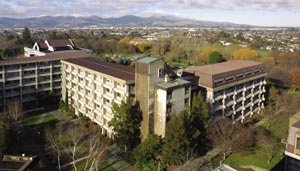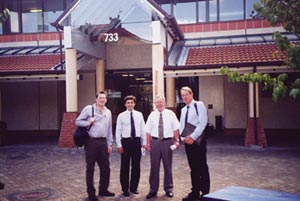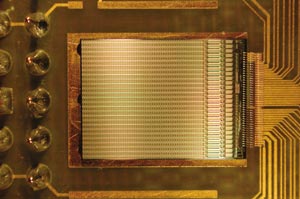New Zealand’s well known natural beauty goes hand-in-hand with geographical isolation. But now a new research initiative is set to strengthen the bonds between the land of Ernest Rutherford and the international particle physics community.

In June, two New Zealand universities formally applied to join the CMS experiment at CERN’s Large Hadron Collider (LHC). This marked the launch of an initiative to establish a New Zealand high-energy particle physics and instrumentation programme called NZ_CMS. The basis of this programme is the formation of an experimental particle physics and instrumentation research group within New Zealand that not only contributes directly to the CMS experimental programme, but does so in a way that also optimizes the benefits for New Zealand, its industry and its young researchers. The application was made on behalf of six staff from the universities of Auckland and Canterbury, and also includes several graduate students. In addition, NZ_CMS is receiving support from staff and university groups within the two universities in the fields of electrical engineering, computer science, medical imaging, nanotechnology and optics.
The CMS pixel system was identified as the area where NZ_CMS should contribute, as it provides the best match in terms of personnel, resources, and the focus on instrumentation development sought by Auckland, Canterbury, and the New Zealand government. Over the last year members of NZ_CMS have been working within the CMS pixel community, ensuring a smooth integration into CMS as well as establishing the connections and the technology transfer necessary for the continued development of the programme.
Pixel systems
NZ_CMS has benefited greatly from input from New Zealand, the CMS management and the CMS pixel group at the Paul Scherrer Institut (PSI) in Villigen, Switzerland. Realistic goals have been outlined for long-term benefits and contributions to CMS, whist enabling NZ_CMS to establish itself within the New Zealand academic climate, as well as allowing the shorter-term goals attractive to funding agencies to be achieved. Roland Horisberger, the CMS pixel detector project leader, and the PSI group have strongly supported NZ_CMS, facilitating pixel technology transfer to New Zealand and helping to define the scope of the NZ_CMS deliverables. At present, members of NZ_CMS are working within the PSI pixel group on the pixel control systems and services. As the NZ_CMS collaboration develops, it is expected that the New Zealand-PSI connection will be strengthened, and a training-exchange programme for students, engineers and researchers will be established.

As a sign of the enthusiasm and support for NZ_CMS, the development from initial idea to application for CMS membership has taken only a year and a half, and it has already secured preliminary funding for pixel instrumentation research. The initiative was first presented at the New Zealand Institute of Physics conference in July last year, which was followed by a visit from a CMS-CERN delegation to New Zealand in January.
The week-long itinerary of the delegation, led by John Ellis (representing CERN) and Diether Blechschmidt (representing CMS), included formal meetings with the minister of research, science and technology, the Royal Society of New Zealand and the Universities of Auckland and Canterbury. The delegates also visited Industrial research Ltd (a Crown Research Institute of some 400 staff) and participated in the 18th International Workshop on Weak Interactions and Neutrinos (WIN 2002) held at Canterbury. There was also time for a public lecture by Ellis entitled “From Rutherford to Higgs” in which he described particle interactions using vocabulary from the sport of rugby.
Following the delegation’s visit, Steve Thompson, chief executive officer of the Royal Society of New Zealand, made an official information visit to CERN. Soon afterwards initial funding was obtained from the New Zealand government and it was decided to proceed with the NZ_CMS application to join CMS. It is now hoped that concurrent with the NZ_CMS application New Zealand and CERN can negotiate and sign an agreement on co-operation. This would facilitate the development of the country’s participation in the LHC.
Current programmes
In an effort to build on its strengths and resources, NZ_CMS is endeavouring to work in conjunction with the country’s existing particle physics programmes. Current areas of research in New Zealand include heavy-ion physics at Auckland, ultra-high-energy neutrino physics at Canterbury and theoretical physics at Massey University.

In addition to the University of Auckland’s taking a leading role in the NZ_CMS pixel programme with the establishment of a pixel laboratory at its Tamaki campus, Auckland’s David Krofcheck is augmenting NZ_CMS’s contribution to CMS through reaction-plane studies for the CMS Heavy Ions programme. This follows on from work done with gold-gold collisions at the E895 experiment at Brookhaven in the US. E895 used the Alternating Gradient Synchrotron (AGS) to deliver gold beams of 2, 4, 6 and 8 GeV per nucleon to measure the excitation functions of collective nuclear matter “flow”. The NZ_CMS Heavy Ions group currently consists of three researchers and is based entirely at the University of Auckland.
As far as Canterbury is concerned, its particle physics group is participating in the Radio Ice Cherenkov Experiment (RICE) in Antarctica. RICE is a neutrino telescope at the south pole using radio antennas to detect the coherent emission of radio-wavelength Cherenkov radiation from the electromagnetic shower of particles produced when an ultra-high-energy electron neutrino interacts in the ice. The Canterbury group is involved in the Monte-Carlo simulation of the shower and the subsequent detection of the Cherenkov pulse, and the investigation into other possible physics sources such as the transition radiation from air showers. The absence of any neutrino events in the data analysed to date implies upper limits for the neutrino flux comparable to the air shower experiments AGASA and Fly’s Eye over the neutrino energy range of around 107-1012 GeV.
With research into medical imaging instrumentation, digital-signal processing and nanotechnology, Canterbury is also looking to establish instrumentation applications associated with pixel systems and pixel data visualization. These would tie in with its new HITLab NZ, the annex of the Human Interface Technology Laboratory (HITLab) at the University of Washington in Seattle. The HITLab consortium is a world leader in virtual-reality technology such as remote surgery and virtual retinal display, which scans images directly into the retina of the eye.
An additional aspect to be developed is online and offline computing, with a contribution from New Zealand now being possible thanks to the installation of the high-bandwidth transpacific Southern Cross Cable, which started operation in late 2000. The cable removes the bandwidth bottleneck between Australasia and the United States, and delivers 120 Gbit/s of fully protected capacity (the equivalent of eight full-length motion pictures every second). An upgrade in early 2003 will double capacity to 240 Gbit/s. At present, the currently available bandwidth to the US from within the universities is around 100 Mbit/s. This removal of bandwidth constraints, coupled with a developing interest in GRID research within New Zealand’s IT community, has prompted discussion of possible contributions to online and offline computing within the context of NZ_CMS.
The third component of New Zealand’s existing particle physics programme is the theoretical physics group at Massey University, which focuses on nucleon-structure functions and deep inelastic scattering calculations. Their interest in NZ_CMS is ongoing, as experiments at the LHC are an excellent opportunity for studying quark and gluon distribution functions. Detailed knowledge of these distribution functions is needed for much of the physics that will be performed at the LHC, and the NZ_CMS programme will enable the Massey group to participate directly in a facility that should contribute significantly to this area of research.
Finally, the NZ_CMS initiative should be seen as part of the resurgence in New Zealand particle physics that looks to work in close collaboration with both the country’s established research groups and our international collaborators (PSI and CMS/CERN). This is a significant step towards New Zealand’s participation in the truly global “big science” projects associated with modern high-energy particle physics laboratories, and is based on access to research at the frontier of particle physics.
The NZ_CMS initiative is also a way to combat New Zealand’s perceived geographical isolation and the continued “brain drain” of young researchers who venture overseas for graduate and career opportunities – often never to return.
This brain drain is, of course, not a new phenomenon. One of the best documented cases is a young Kiwi (New Zealander) called Ernest Rutherford, who left the country in 1895 to work with J J Thompson at Cambridge University’s Cavendish Laboratory. NZ_CMS intends to reunite quarks and Kiwis in New Zealand!








